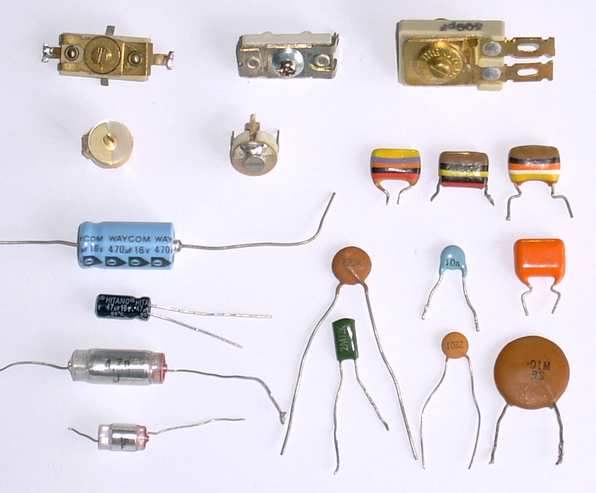Contents
Electronics deals with circuits and the one who deals with it should be aware about each and every component used. Not only the component but also its values matters the most. Slight change in value will lead to terrible errors, so to avoid that problem one must be aware of selecting the component values and to check whether it is right or not.
Most of us is aware about resistor color code but only few know to identify the capacitance values. So here I’m going to discuss how capacitor codes are identified.
Generally for large capacitors, the actual values of Capacitance, Voltage or Tolerance are marked in the body of the capacitors in the form of alphanumeric characters.
But for smaller disk capacitor (ceramic capacitor) along with plastic film capacitors usually comes with very small values ranging in Pico and Nano farads. We usually see 3 numbers along with an alphabet along with it.
We usually got confused about how to understand the values of such capacitors.
Types of Capacitor Codes
The capacitor manufactures uses two methods of coding :
- Color coding
- Number coding
Color Coding
The unpolarised mica and polyester molded capacitors are color coded, similar to the color coding of resistor. The color is noted from Top to Bottom. The first color is considered as 1st digit, second color obviously 2nd digit, the third one is multiplier, the 4th one is tolerance and the fifth one is voltage rating.
Capacitor Color Code Table
| Color | Digit 1 | Digit 2 | Multiplier | Tolerance | Tolerance* | Voltage |
|---|---|---|---|---|---|---|
| Black | 0 | 0 | 1 | ±20% | ±2.0pF | 100 |
| Brown | 1 | 1 | 10 | ±1% | <±0.1pF | 200 |
| Red | 2 | 2 | 100 | ±2% | ±0.25pF | 300 |
| Orange | 3 | 3 | 1000 | ±3% | – | 400 |
| Yellow | 4 | 4 | 10000 | ±4% | – | 500/td> |
| Green | 5 | 5 | 100000 | ±5% | ±0.5pF | 600 |
| Blue | 6 | 6 | Not Used | – | – | 700 |
| Violet | 7 | 7 | Not Used | – | – | 800 |
| Grey | 8 | 8 | 0.01/td> | +80%,-20% | – | 900 |
| White | 9 | 9 | 0.1 | ±10% | ±1pF | 1000 |
| Digit 1 | Orange | 3 |
| Digit 2 | Yellow | 4 |
| Multiplier | White | 0.1 |
| Tolerance | Red | ±0.25pF |
Capacitor Voltage Color Code Table
| Color | Voltage Rating | ||||
|---|---|---|---|---|---|
| Type J | Type K | Type L | Type M | Type N | |
| Black | 4 | 100 | 10 | 10 | |
| Brown | 6 | 200 | 100 | 1.6 | |
| Red | 10 | 300 | 250 | 4 | 35 |
| Orange | 15 | 400 | 40 | ||
| Yellow | 20 | 500 | 400 | 6.3>/td> | 6 |
| Green | 25 | 600 | 16 | 15 | |
| Blue | 35 | 700 | 630 | 20 | |
| Violet | 50 | 800 | |||
| Grey | 900 | 25 | 25 | ||
| White | 3 | 1000 | 2.5 | 3 | |
- Type J : Diped Tantalum Capacitors
- Type K : Mica Capacitors
- Type L : Polyester/Polystyrene Capacitors
- Type M :Electrolytic 4 Band Capacitors
- Type N : Electrolytic 3 Band Capacitors
Number Coding
The ceramic capacitors have number coding. The important one to be noted is that usually capacitor values range is Pico farads (10-12F). Most of them have 3 numbers. The 3 numbers are having unique significance. The 1st and 2nd numbers are significant digits and 3rd one is a multiplier. Mostly the last digit signifies how many zeroes to be added after the first two digits.
The multiplier table is given below.
| Third Digit | Multiplier Value |
|---|---|
| 0 | 1 |
| 1 | 10 |
| 2 | 100 |
| 3 | 1000 |
| 4 | 10000 |
| 5 | 100000 |
| 6 | Not Used |
| 7 | Not Used |
| 8 | 0.01 |
| 9 | 0.1 |
So 104K means 10+4 zeroes in pF which is also same as 0.1uF or 100nF.Same procedure in the case of capacitor marked as 103,102 etc.
The alphabet represents the tolerance. Here K means it is having a tolerance of +/- 10%
Various letters are used for corresponding tolerances.
The tolerance table is given below
| Code | Tolerance | Code | Tolerance |
|---|---|---|---|
| A | ±0.05pF | K | ±10% |
| B | ±0.1pF | L | ±15% |
| C | ±0.25pF | M | ±20% |
| D | ±0.5pF | N | ±30% |
| E | ±0.5% | P | 0 to 100% |
| F | ±1% | S | -20 to 50% |
| G | ±2% | W | 0 to 200% |
| H | ±3% | X | -20 to 40% |
| J | ±5% | Z | -20 to 80% |
The only difference between the color coding and number coding is, the numbers are directly printed to represent the significant digits and the other parameters.
